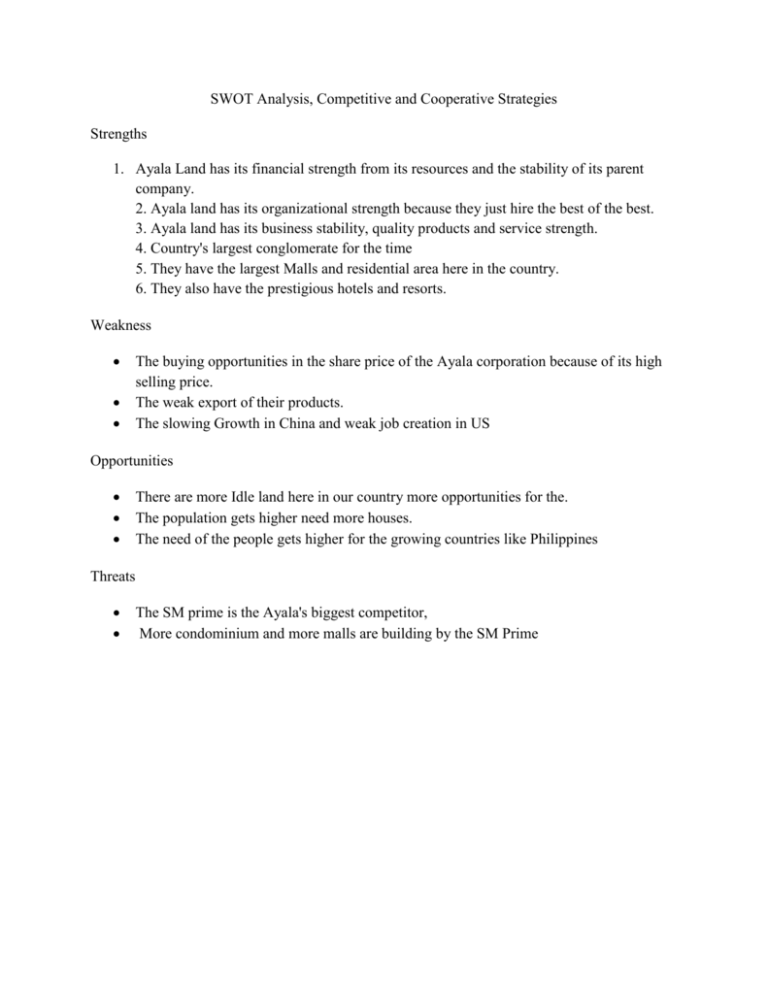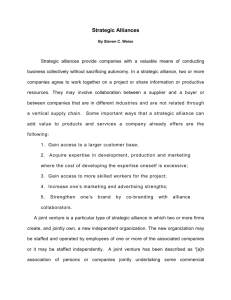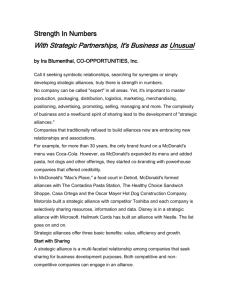Word Copy - Business Policy and Strategy
advertisement

SWOT Analysis, Competitive and Cooperative Strategies Strengths 1. Ayala Land has its financial strength from its resources and the stability of its parent company. 2. Ayala land has its organizational strength because they just hire the best of the best. 3. Ayala land has its business stability, quality products and service strength. 4. Country's largest conglomerate for the time 5. They have the largest Malls and residential area here in the country. 6. They also have the prestigious hotels and resorts. Weakness The buying opportunities in the share price of the Ayala corporation because of its high selling price. The weak export of their products. The slowing Growth in China and weak job creation in US Opportunities There are more Idle land here in our country more opportunities for the. The population gets higher need more houses. The need of the people gets higher for the growing countries like Philippines Threats The SM prime is the Ayala's biggest competitor, More condominium and more malls are building by the SM Prime Competitive Strategies Cost Leadership Strategies This can be used for allow cost producer within a mass, the cost leadership is often driven by company efficiency, size, scale, scope and cumulative experiences. The Cost leadership Strategy aims to exploit scale of production, well defined scope and other economies, the example is a good purchasing approach, producing highly standardized products using high technology. The cost leadership is different fro price leadership. This is usually gained by companies that are able to achieve economies of scale in production and marketing. Differentiation Strategies Approach under which a firm aims to develop and market unique products for different customer segments. Usually employed where a firm has clear competitive advantages, and can sustain an expensive advertising campaign. Differentiation is used when offering something unique that is perceived by the consumer to be better or different to other products. A differentiation strategy can provide a competitive advantage by differentiating your business from your competitors and at the same time offering what your customers need. A differentiation strategy will pursue a unique position among your competitors. The aim of the strategy is for the business to become unique in the minds of its customers. For example, you can offer a specific design that your competitors cannot offer and target a specific group of consumers. The aim of differentiation strategy is to create brand loyalty, which in turn can create price in elasticity on the part of buyers. As a result, customers will be less sensitive on price decisions, and more sensitive on the actual product. In turn, it can erect competitive barriers to entry, higher margins and possibly mitigate the power of buyers who will eventually lack acceptable substitute products. When altering factors like design , technologies and more to differentiate yourself, it is important to focus on the customer’s needs in order to design those factors appropriately. Differentiating the product or service of the firm means creating something that is perceived industry wide as being unique. Differentiation may take the form of design or brand image, technology, product feature, customer service, dealer network, etc. Ideally, the firm differentiates itself among several dimensions that are important to the customer. Differentiation does not mean that the firm will ignore costs, although costs are not the primary strategic target. Achieving differentiation may preclude gaining a high market share since it often requires a perception of exclusivity. Achieving differentiation implies a trade-off with a cost position if the activities required in creating it are inherently costly, such as extensive research. Focus Strategies A marketing strategy in which a company concentrates its resources on entering or expanding in a narrow market or industry segment. A focus strategy is usually employed where the company knows its segment and has products to competitively satisfy its needs. The focus strategy targets a particular buyer group, segment of the product line, or geographic market. Whereas low cost and differentiation are aimed at achieving their objective industry wide, focus is build around serving a particular target or niche extremely well. The strategy rests on the premise that the firm can serve its narrow strategic target more effectively or efficiently than more broadly based competitors. The firm may achieve differentiation from better meeting the needs of the particular target or lower costs in serving the target. If the firm is good or lucky, it may manage to do both. Even though the focus strategy does not achieve low cost or differentiation from the perspective of the market as a whole, it does achieve one or both in its narrow market target. The focus strategy always implies some limitations on the overall market share achievable and involves a trade-off between profitability and sales volume, but not necessarily a trade-off with overall cost position. Often the focus strategy of filling a limited need or offering a product that only a few buyers will purchase allows for products to be priced at a premium since the company is satisfying the desires of a small cluster of buyers. Most winning midsize growth companies are leaders in market niches, often in markets they have created through innovation. Such niche strategies are often born of necessity, since these firms lack the resources to fight broad, head-to head battles with larger, entrenched competitors. They succeed by seeking out niches that are too small to interest the giants. Alternatively, some firms pick niches that can be captured and protected by sheer perseverance and by serving customers extremely well. Cooperative Strategies A strategy in which firms work together to achieve a shared objective. The Cooperative Strategy involves Strategic alliances represents a shift from achieving strategic competitiveness and above-average returns through competitive strategy (establishing strong positions against external challenges, minimizing weaknesses, and maximizing core competencies) to achieving them through cooperative strategies. There are a number of justifications or rationales for strategic alliances. These reasons vary by market situation--slow-cycle, standard-cycle or fastcycle. Reasons for entering alliances in slow-cycle markets gaining access to a market that is not open to other entry strategies establishing a franchise in a new market maintaining market stability Reasons for entering alliances in standard-cycle markets gaining market power gaining access to complementary resources overcoming trade barriers meeting competitive challenges from other competitors pooling resources for very large capital projects learning new business techniques Reasons for entering alliances in fast-cycle markets speeding up the development of goods/services speeding up new market entry maintaining market leadership forming an industry technology standard sharing risky R&D expenses overcoming uncertainty A strategic alliance is the primary cooperative strategy and represents a partnership between companies whereby companies' resources, capabilities, and core competencies are combined to pursue mutual interests to develop, manufacture, or distribute goods or services. They represent explicit forms of relationships between companies. Types of Alliances There are three basic types of explicit strategic alliances: 1. A joint venture is an alliance where a new, independent company is formed from two or more partners, with each partner company contributing assets. 1. An equity strategic alliance is an alliance where partner companies own unequal shares of equity in the venture and are considered to be superior at passing on know-how between companies because they are closer to hierarchical control than nonequity alliances. For example, Ford Motor Company and Mazda Motor Corporation formed a long-standing equity strategic alliance. 1. A non equity strategic alliance is an alliance where a contract is given to supply, produce, or distribute a company's products without any equity sharing. Other types of non equity strategic alliances include licensing, distribution agreements, supply contracts, and marketing agreements (such as code-sharing agreements among airlines). For example, OPEC seeks to manage the price and output of oil companies in member countries. These strategic alliances represent explicit alliances. However, there also are implicit cooperative alliances such as tacit collusion, which exists when several companies in an industry tacitly cooperate to reduce industry output below the potential competitive level to maintain higher-than-competitive-level prices. Another form of tacit collusion is mutual forbearance, which is a recognition of interdependence. These forms of cooperative alliances are illegal unless regulated by the government, which is currently the case in the power industry. The number of companies with multiple alliances continues to increase. Companies use alliance networks as a foundation for a network cooperative strategy for several reasons: to share complementary resources, capabilities, and competencies to exploit emerging technologies to share the risk and cost of large capital investments to keep pace with or establish industry standards This last reason is particularly important in the computing and telecommunications industries, in which the standard-setter can potentially dominate (consider Windows and Intel in the personal computer industry). Alliance networks are also important in industries in which rapid change and company reinvention are necessary for long-term survival. Networked companies can gain exposure to an array of developing technologies and provide the company with strategic, technical, and operational options for experimentation. There are several issues that should be addressed when forming an alliance network: determining whether the alliance should be horizontal or vertical deciding the number of companies to be networked so that effectiveness and efficiency are maximized determining how to minimize member company conflicts specifying the strategic intent of the alliance so that all members benefit determining how the network will be managed Failure to address these issues reduces the potential for alliance success. Because companies that are cooperating also may be competing with each other, significant risks accompany cooperative strategies. These risks include: poor contract development that may result in one (or more) of the partners acting opportunistically and taking advantage of other venture partners misrepresentation of partner companies' competencies by misstating or exaggerating an intangible resource such as knowledge of local market conditions failure of partner companies to make complementary resources available to the venture being held hostage through specific investments (whose value is associated only with the venture or partner), especially if laws in a foreign country do not protect investments in the case of nationalization (or re-nationalization with a change in governments) misunderstanding a partner's strategic intent In addition to the risk that a partner may cheat or act opportunistically, there also are competitive risks to cooperative strategies, such as: the capability to form and manage a joint venture effectively, the capability to collaborate, the ability to identify trustworthy venture partners. Trust between partners increases the likelihood of alliance success and may be the most efficient mechanism for governing economic transactions. Trust creates confidence between partners that actions taken will serve both parties' interests. Trust increases the probability that a company will understand its partner's actual strategic intent as it participates in an alliance, which leads to more predictable partner actions. If both partners are trustworthy, companies are able to allocate fewer resources to monitor and control the alliance. Trust is valuable, rare, imperfectly imitable, and often non substitutable, thus yielding competitive advantage when forming and using cooperative strategies. Partner trustworthiness reduces the company's concern about the inability to control or influence each operational aspect of an alliance through a contractual agreement. The two basic approaches to managing cooperative strategies that come out of this discussion are: cost-minimization and value-creation maximization. 1) The cost minimization approach requires companies to develop capabilities to create effective partner contracts and contract monitoring capabilities. However, these contracts have drawbacks. Writing protective contracts and developing effective monitoring systems are costly. Protective contracts and monitoring, by shielding parts of each organization from the other, may limit opportunism and preclude the organizations from taking advantage of unforeseen opportunities. 2) The value-maximization approach requires partners with complementary assets and emphasizes trusting relationships. As a strategic asset, trust can enable partner companies to reduce the cost of contracting and monitoring because the probability of opportunistic behavior is reduced if partners are able to trust each other. Trust also may enable the venture to take advantage of unforeseen opportunities. Thus, because trust will enable partner companies to reduce venture related contracting and monitoring costsand add to the venture's flexibility, a venture between partners that can be trusted is more likely to be able to both reduce costs and add or create value.








